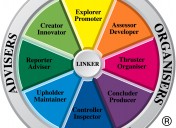6 learning methods that pay dividends
 Given this month’s theme of learning, I began thinking about organisational learning, individual learning, and why investing in learning is important. I reflected on my own learning journey and picked out my favourite learning models and approaches. I’ve found them consistently useful over the years and hugely beneficial to my career.
Given this month’s theme of learning, I began thinking about organisational learning, individual learning, and why investing in learning is important. I reflected on my own learning journey and picked out my favourite learning models and approaches. I’ve found them consistently useful over the years and hugely beneficial to my career.
1. Discovery
We’re not at school anymore and the rules have changed. Learning can be FUN. The great thing about facilitating adult learning is that it’s about creating opportunities to uncover or invent rather than force or tell.
TIP: Create opportunities for yourself and others to discover information, whether it be through research, activities, or talking to other people.
2. 4MAT
Bernice McCarthy developed the 4MAT model. While it was initially developed for use in schools, I’ve applied it to learning, communication, sales, etc.
According to McCarthy, there are four learning styles, and therefore four different questions, that should be accounted for when delivering new information.
- WHY (35% prefer to know WHY). What’s in it for the reader? This is the big benefit or payoff driving the action
- WHAT (22% prefer to know WHAT). The facts, content, information. The theory
- HOW (18% prefer to know HOW). Details about how things work, practical steps and procedures, practice sessions
- WHAT IF/WHAT ELSE (25% prefer to know WHAT IF). Q&A, options and alternatives, and experimentation.
If you’re a leader with a team of 15 people and you begin communicating with a ‘How’, this means it’s possible that 57% (8-9) of your team are not really hearing your message, and you’ll have to work a lot harder to engage them.
TIP: You can use this model for everyday tasks such as email writing. Rather than jumping straight into a WHAT or HOW, ensure that you cover the WHY first. Jot down the Why, What, How and What if questions as headings to prompt your email narrative.
3. DEDICT
My pilates instructor, who is brilliant, has a great model of teaching. The DEDICT approach is great for all skills-based training.
D – Demonstrate. Provide learners with real-time demonstrations so that they can see what they are aiming to achieve.
E – Explain. Explain a skill in enough detail for learners to understand the major requirements of the skill or task, highlighting main areas.
D – Demonstrate slowly. Demonstrate again, and this time slowly so that the learners have enough time to focus on the various aspects of what’s required.
I – Imitate. Now it’s time for the learner to begin their practice by slowly imitating your demonstration while you supervise.
C – Coach. Support the learner as they start to modify and refine their initial imitation. Coaching involves critical distinctions so that learners can refine their skills.
T – Trial or Test. Learners test their skills while practicing independent of the facilitator.
TIP: When you next show someone how to do something, challenge yourself to find a way to use this model.
4. Honey and Mumford Learning Styles
Individuals naturally prefer certain learning approaches. To maximize one’s own personal learning, it’s helpful to understand your learning style and to seek out opportunities to learn how to best use that style.
Based on the work of Kolb , the concept of learning styles was developed by Peter Honey and Alan Mumford, who identified four distinct learning styles or preferences: activist, theorist, pragmatist, and reflector.
Note: to be an effective learner, you should develop the ability to learn in multiple styles.
I’m a cross between a Theorist and Reflector, what are you?
To find out more, you can complete an abridged version of the Honey and Mumford questionnaire.
5. The Super-Memo model
How great would it be to remember everything you have ever learned? Polish researcher Piotr Wozniak created a learning programme called Super-Memo that shows that, while we all have a tendency to forget things, if you refresh your memory at one, ten, thirty, and sixty days after an original learning experience, the likelihood of you remembering what you learned greatly increases.
Therefore, if you invest in your personal development, whether it be in terms of time and/or money, make sure to also set up follow-up learning refreshers. Try flicking through a workbook or simply talking to someone about the learning experience.
6. Invest in your personal development
The income potential of your career is your greatest asset. Your career is the golden goose that lays golden eggs: house, cars, kids in private school, and investment accounts.
Invest at least 3% of your income in yourself.
Following this rule, if you earn $60,000 pa, your investment would equate to $1800 ps. If you can pay $150 per month for mobile phones and/or Foxtel, you should have no issue committing $150 to yourself.
Which learning method appeals most?
Have you heard or used any of these learning methods before?
Do you believe learning models can improve your skills, behaviours, and career?
Let us know.
As always, enjoy your learning journey.
Joanna – Ancora Learning Expert Learning and Development Consultant
Joanna is a skilled consultant, facilitator and coach.
She helps organisations build a customer-first environment and create high performing teams that deliver exceptional results; a must in today’s competitive business environment.
For more information on the best learning models for you
Call 1300 ANCORA (262 672)



















